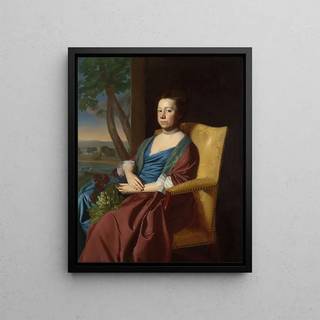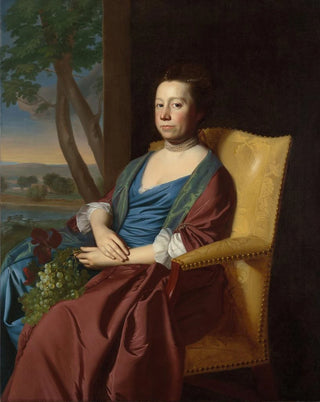Art print | Elizabeth Storer Smith - John Singleton Copley


View from behind

Frame (optional)
Elizabeth Storer Smith - John Singleton Copley Art print – Captivating introduction
The "Elizabeth Storer Smith" artwork by John Singleton Copley is a quintessential example of 18th-century American portraiture. This painting, which captures the essence of its subject with remarkable finesse, transports us to a time when art was both a reflection of society and a means of asserting social status. Copley, through his skillful play with light and textures, manages to create an intimate atmosphere that invites the viewer to ponder the life of this woman, her thoughts, aspirations, and environment. The depiction of Elizabeth Storer Smith, with her penetrating gaze and dignified attitude, immerses us in a universe where every detail matters, revealing the complexity of the human condition.
Style and uniqueness of the artwork
What sets this piece apart is the way Copley manages to capture not only the physical appearance of his model but also a part of her soul. The choice of colors, with rich tones and delicate nuances, highlights Elizabeth Storer Smith's personality while demonstrating exceptional technical mastery. The precision of the features, the softness of the drapery, and the subtle use of light create a depth that is rare in portraiture of the period. Copley does not merely reproduce a face; he tells a story, that of a woman of his time, playing with portrait conventions to offer a more nuanced and human vision. This innovative approach makes "Elizabeth Storer Smith" a work that transcends simple portrait conventions to become a poignant testimony of its era.
The artist and his influence
John Singleton Copley, born in Boston in 1738, marked the history of American art with his ability to combine European tradition and local sensibility. Trained in a context where portraiture was the predominant artistic genre, Copley succeeded in establishing himself thanks to his exceptional talent and his desire to explore new horizons. His works, often imbued with deep psychology, testify to a meticulous observation of characters and human emotions. Copley also played a key role in the evolution of American art by introducing elements of realism that would influence generations of artists. In representing historical figures

Matte finish

View from behind

Frame (optional)
Elizabeth Storer Smith - John Singleton Copley Art print – Captivating introduction
The "Elizabeth Storer Smith" artwork by John Singleton Copley is a quintessential example of 18th-century American portraiture. This painting, which captures the essence of its subject with remarkable finesse, transports us to a time when art was both a reflection of society and a means of asserting social status. Copley, through his skillful play with light and textures, manages to create an intimate atmosphere that invites the viewer to ponder the life of this woman, her thoughts, aspirations, and environment. The depiction of Elizabeth Storer Smith, with her penetrating gaze and dignified attitude, immerses us in a universe where every detail matters, revealing the complexity of the human condition.
Style and uniqueness of the artwork
What sets this piece apart is the way Copley manages to capture not only the physical appearance of his model but also a part of her soul. The choice of colors, with rich tones and delicate nuances, highlights Elizabeth Storer Smith's personality while demonstrating exceptional technical mastery. The precision of the features, the softness of the drapery, and the subtle use of light create a depth that is rare in portraiture of the period. Copley does not merely reproduce a face; he tells a story, that of a woman of his time, playing with portrait conventions to offer a more nuanced and human vision. This innovative approach makes "Elizabeth Storer Smith" a work that transcends simple portrait conventions to become a poignant testimony of its era.
The artist and his influence
John Singleton Copley, born in Boston in 1738, marked the history of American art with his ability to combine European tradition and local sensibility. Trained in a context where portraiture was the predominant artistic genre, Copley succeeded in establishing himself thanks to his exceptional talent and his desire to explore new horizons. His works, often imbued with deep psychology, testify to a meticulous observation of characters and human emotions. Copley also played a key role in the evolution of American art by introducing elements of realism that would influence generations of artists. In representing historical figures






